How to ferment cabbage with cabbage correctly: step by step instructions and recipe options
Pickling cabbage is one of the simplest and most common ways of processing vegetables for long-term (more than six months) storage. Cabbage is fermented from the second half of September to mid-November, during this period late and medium late varieties ripen en masse.
Early varieties of vegetables are not suitable for pickling, because they have loose heads of cabbage and green color, they also have less sugar, so they are less fermented. In total, there are several types of sauerkraut in traditional Slavic cuisine: chopped, shredded and cabbage. The article will tell you how to ferment cabbage with heads of cabbage, how to store it and what to use with it.
The content of the article
Advantages and disadvantages of fork fermentation
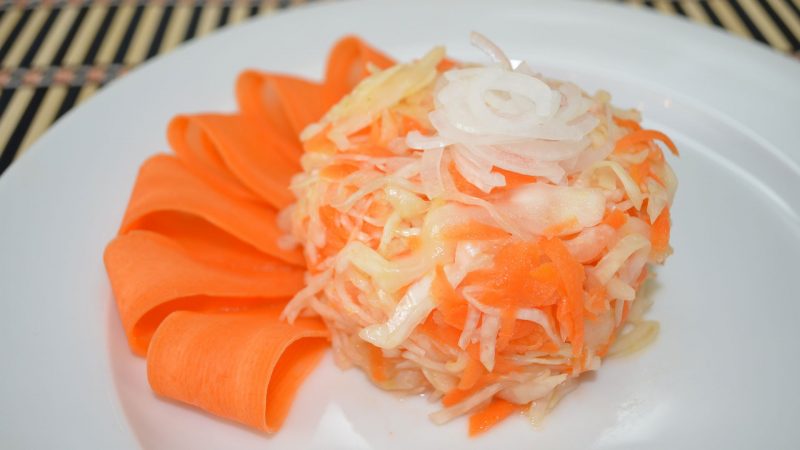
The disadvantage of salting whole cabbage for the winter is that not chopped vegetable takes up a lot of space. To salt cabbage with forks, you will need not only a separate room, but also a special containerfor example barrels. Shredded cabbage can be fermented in regular three-liter jars and stored in the refrigerator or on the balcony.
The advantages include the simplicity of the process, as well as a large number of recipe variations: such cabbage is fermented with caraway seeds, horseradish, apples, coriander, carrots, beets and other vegetables and spices that give the vegetable their beneficial properties and taste. Sauerkraut in forks is a real superfood containing vitamins and minerals essential for the human body.
Table "Chemical composition of sauerkraut"
| Vitamins | Quantity, mg |
| A (retinoids) | 0,6 |
| B1 (thiamine) | 0,03 |
| B2 (riboflavin) | 0,021 |
| B5 (pantothenic acid) | 0,09 |
| B6 (pyridoxine) | 0,13 |
| B9 (folate) | 0,024 |
| C (ascorbic acid) | 31,2 |
| E (tocopherol) | 0,14 |
| K (phylloquinone) | 0,013 |
| PP (niacin) | 0,42 |
| U (methylmethionine) | 0,01 |
How to ferment cabbage with cabbage
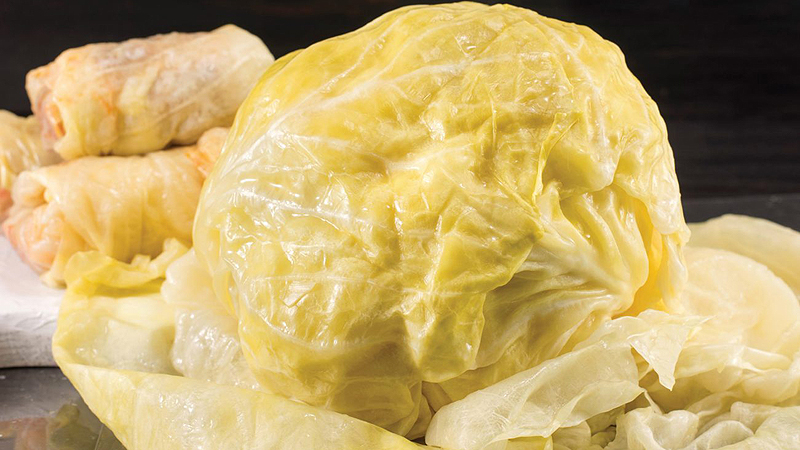
As already mentioned, it is customary to ferment cabbage in the autumn period, when the main crop ripens, suitable for harvesting. In the list of ingredients required for fermentation:
- cabbage - 10 kg;
- carrots - 300 g (3% of the weight of the main vegetable);
- fine salt - 200-250 g (2-2.5% of the weight of the vegetable);
- apples, lingonberry, cranberry - to taste.
A suitable container for harvesting cabbage in forks is a barrel - wooden or plastic. Large metal food pots and large rigid plastic containers will also work. All plastic containers must be suitable for storing food in them.
In addition, it is recommended to pay attention to what was previously stored in it - if not new barrels, pots and containers are used. For example, the smell of a herring that was previously in containers is almost impossible to remove - a piece with a fish smell can be considered spoiled.
Step-by-step instruction:
- Heads of cabbage are cleaned of dirty, rotten and green leaves, stubs are cut.
- Wash, peel and chop the carrots.
- Sprinkle the cabbage with salt.
- The bottom of the container is lined with white leaves.
- Green leaves, a plastic napkin and an oppressive circle are covered on top of all the cabbage, oppression is installed on the container.
- The brine should come out on the surface of the undercutting circle after 24 hours.
- Gas bubbles and foam (signs of fermentation) are removed.
- Every 1-2 days, pierce the workpiece in several places to the bottom with a smooth pointed stick. The procedure is repeated until gas with a pungent odor is no longer emitted from the holes.
- After the vegetable has settled (by 20-30 cm), the oppression, circle, napkin, leaves and brown forks are removed.
- The pressure circle is washed with hot soda solution.
- The napkin is washed in water, then in saline solution.
- With a wrung out napkin, cover the workpiece in the container again.
- The edges of the napkin are tucked into the container.
- Cover with a circle and less oppression.
- The brine should protrude to the edge of the bending circle, otherwise, the brine is increased or added.
Harvesting in heads of cabbage is considered ready when lactic acid fermentation ends, and the vegetable becomes amber-yellow in color and acquires a pleasant aroma. The brine should be cloudy yellow and have a sour-salty taste. The workpiece is ready in about 15-20 days.
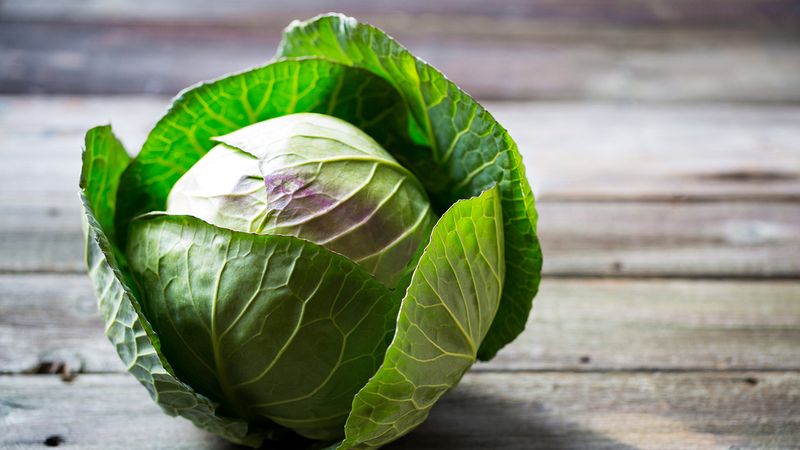
How to salt cabbage in halves
The vegetable is fermented with both heads of cabbage and halves. For harvesting, dense heads of cabbage of late varieties are used.
Ingredients:
- cabbage - 10 kg;
- water - 8 l;
- salt - 320 g.
Preparation:
- Heads of cabbage are cleaned of spoiled and green leaves, stubs are cut.
- The bottom of the container is lined with green leaves.
- Vegetables are placed in a container.
- Green leaves, a napkin and a depressing circle are laid on top of the cabbage, and oppression is on top.
- Pour everything with 4% brine (400 g of salt per bucket of water)
- Every 1-2 days, the workpiece is pierced to release the gas.
The workpiece is ready in about three weeks.
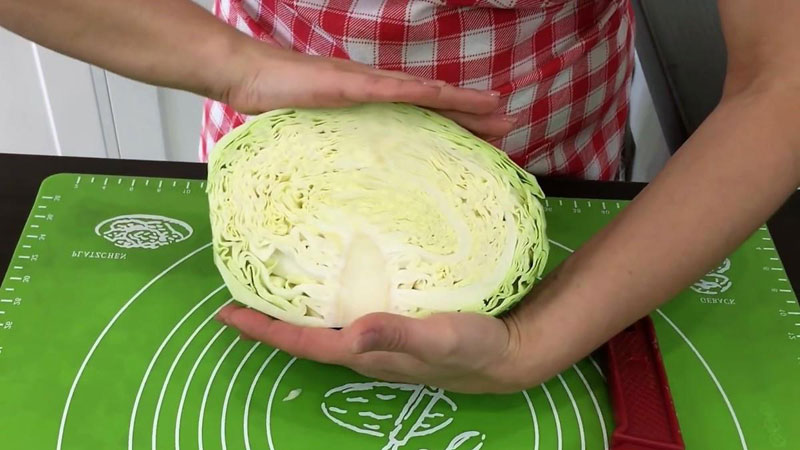
Cabbage halves with shredded cabbage and carrots
Heads of cabbage and halves are also salted with chopped cabbage and carrots.
Ingredients:
- cabbage - 10 kg;
- carrots - 300 g;
- salt - 200 g
Preparation:
- Carrots are added to the chopped cabbage.
- Grind vegetables with salt.
- Put vegetables in a container with a layer of 30 cm.
- Heads of cabbage or halves are laid.
- Put chopped cabbage, etc.
- Cover with green sheets, a napkin, around and put under oppression.
- They pierce to release the gas every 1-2 days until all of it comes out.
Readiness comes in about 15-20 days.
Blanched cabbage halves
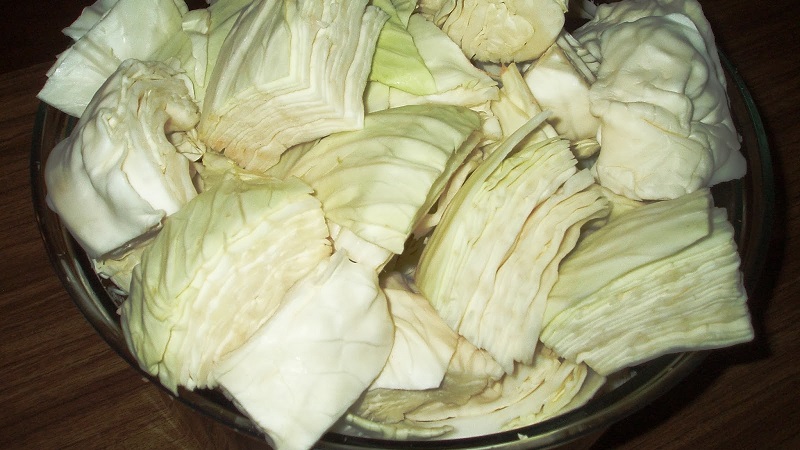
There is also a way to ferment blanched cabbage in halves, we will also consider it.
Ingredients:
- cabbage - 10 kg;
- salt - 600 g.
Preparation:
- Heads of cabbage are blanched in boiling salted water for 2-3 minutes.
- The cooled vegetables are tamped tightly into a container and sprinkled with salt.
- Cover with green sheets, a napkin, around and put under oppression for 15-20 days.
Pickling with vinegar
Consider an interesting recipe for pickling blanched heads of cabbage with vinegar. The product is spicy and ideal for a snack menu.
Ingredients:
- cabbage - 10 kg;
- allspice - 1 g;
- bay leaf - 2 g;
- sugar - 20 g;
- salt - 10 g;
- vinegar - 20 g;
- broth - 1 l.
Preparation:
- Peel the vegetable, cut the heads of cabbage into halves and blanch in boiling water.
- Cool forks and broth.
- Put the halves in a container, add salt, sugar, allspice, bay leaf and vinegar to them.
- Cover with a napkin, around and put under oppression.
- Pour cold broth for three days.
Recipe variations
Among the variety of recipes for sauerkraut with forks, consider some of the most interesting and delicious.
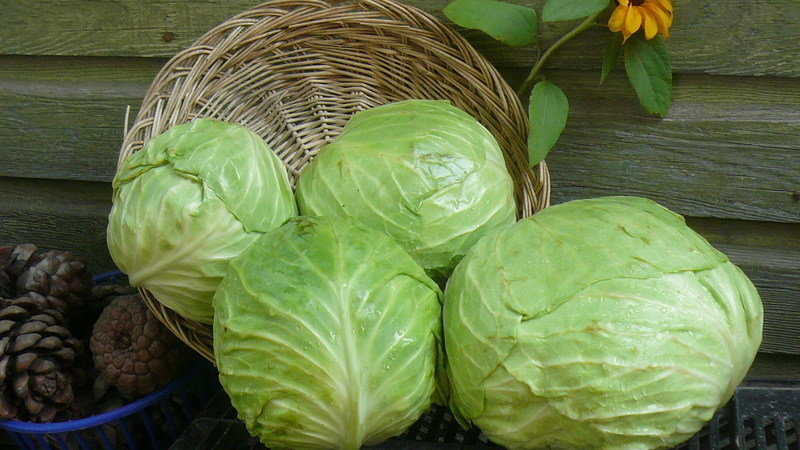
With pickled mushrooms
White cabbage with pickled mushrooms is often found in Slavic cuisine. To do this, the heads of cabbage are fermented in the usual way with carrots, which was described above. After fermentation is over, the vegetable is laid out in a small container and mixed with chopped pickled mushrooms.
Ingredients:
- cabbage - 10 kg;
- carrots - 300 g;
- salt - 160 g;
- pickled mushrooms - 900 g.
With parsnips
Heads of cabbage are fermented according to the classic recipe with carrots, and parsnips are added after fermentation is over.
Ingredients:
- cabbage - 10 kg;
- carrots - 600 g;
- fresh parsnips - 300 g;
- salt - 200 g
Heads of cabbage with beets
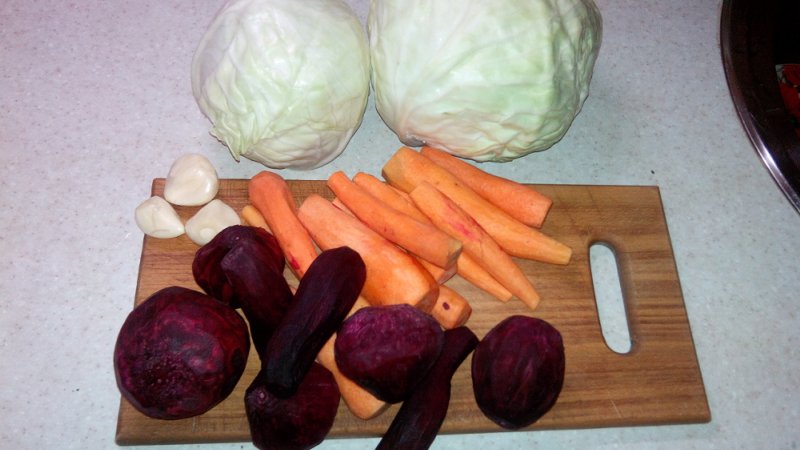
Forks are fermented with beets, peeled and blanched for 2-3 minutes in boiling water. Cabbage forks are placed in a container and put with chopped beets. Fermentation takes place according to the same principle as usual.
Ingredients:
- cabbage - 10 kg;
- table beets - 400 g;
- salt - 170 g.
Heads of cabbage with cucumbers
Not only spices are added to cabbage, berries, fresh vegetables and fruits, but also pickles. The cucumbers are slightly compressed, but crispy, with a cabbage smell. The workpiece acquires the sharpness of cucumbers and a slight sourness.
Ingredients:
- cabbage - 10 kg;
- carrots - 330 g;
- strong pickled cucumbers - 7-8 kg.
Preparation:
Forks, chopped carrots and pickles are placed in a container covered with cabbage leaves in layers of 20-30 cm.
They finish tamping with cabbage, cover it with sheets, put a circle and put it under oppression for 30 days.
"Provencal"
Cabbage "Provencal" is prepared from pickled forks, to which are added pickled apples, pickled stone fruits, grapes, cranberries, lingonberries, sugar and vegetable oil. Provencal cabbage is prepared according to various recipes.
Ingredients:
- cabbage - 5 kg;
- sugar - 3.7 kg;
- vegetable oil - 700 g;
- mustard powder - 1 g;
- cranberries or lingonberries - 450 g;
- pickled fruits - 450 g;
- pickled grapes - 450 g;
- soaked apples - 500 g;
- marinade left over from stone fruits - 350 g.
Preparation:
- The vegetable is chopped.
- Sugar and mustard are added to it.
- The apples are cut into eight pieces.
- The vegetable oil is filtered through cheesecloth.
- A mixture of white cabbage, berries, stone fruits and apples is placed in a container, but not rammed.
- Pour over the strained marinade.
- Store at temperatures from 0 to + 5 ° C for 10 days.
How to apply

Sauerkraut forks are used both as an independent dish and as part of complex recipes. The finished product is not placed entirely on the table; it must be cut or shredded. Sauerkraut is an excellent appetizer for alcoholic drinks and a traditional part of the garnish... In post-Soviet canteens, for example, you can find a shredded piece, pickled in heads of cabbage, on a plate with mashed potatoes and a cutlet.
The vegetable is also used as an independent dish: it is poured with oil, seasoned with pepper, onion and garlic. For a beautiful presentation to the festive table, the shredded vegetable is decorated with herbs, pomegranate seeds, grapes, lemon and cranberries.
Pickled barrel vegetable is found in classic borscht, cabbage soup, stewed with meat, stuffed with fish for baking. Also, the fermented product is suitable for filling in pies and pies, it is put in salads, and the pickle from the heads of cabbage is suitable as a medicine against a hangover.
Terms and conditions of storage
Any fermented forks, regardless of the cooking recipe, are stored in a cool place at temperatures from 0 ° C to + 4 ° C. So the vegetable will retain its taste and useful properties for up to eight months. At temperatures from +5 to + 8 ° C, the product is stored for no more than two weeks, then it begins to oxidize.
The cold will destroy vitamin C and spoil the taste, therefore, it is not recommended to freeze the heads of cabbage.
An important condition for preserving the product is the presence of brine. It must completely cover the workpiece.
Conclusion
Cabbage in heads of cabbage is not so difficult to prepare for the winter, the main thing is to choose for this late varieties and a spacious container - a barrel or a box. It is recommended to make sure that the plastic from which the container is made is food grade and free of foreign odors.
The recipe is chosen to your taste, but it is required to strictly observe the fermentation technology, otherwise the product will be spoiled. Use the workpiece up to eight months from the date of manufacture, the main thing is to store it in brine at a temperature not higher than + 4 ° C.